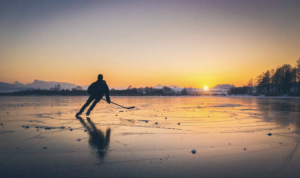4
These are difficult stories. We bear witness in this chapter to the role of sport in furthering the settler colonial projects throughout Turtle Island. Here are some supports to access in the community and from a distance:
First Peoples House of Learning Cultural Support & Counselling
Niijkiwendidaa Anishnaabekwag Services Circle (Counselling & Healing Services for Indigenous Women & their Families) – 1-800-663-2696
Nogojiwanong Friendship Centre (705) 775-0387
Peterborough Community Counselling Resource Centre: (705) 742-4258
Hope for Wellness – Indigenous help line (online chat also available) – 1-855-242-3310
LGBT Youthline: askus@youthline.ca or text (647)694-4275
National Indian Residential School Crisis Line – 1-866-925-4419
Talk4Healing (a culturally-grounded helpline for Indigenous women):1-855-5544-HEAL
Section One: History
A) The Residential School System
Exercise 1: Notebook Prompt
We are asked to honour these stories with open hearts and open minds.
Which part of the chapter stood out to you? What were your feelings as you read it? (50 words)
| Something that stood out to me from this chapter was the contrast between the images of residential schools, which portray an idealized version of education, and the lived experiences of the students. I felt a deep sense of discomfort, realizing how these images distort the truth of trauma and erasure. It made me reflect on how history is shaped by what is recorded and remembered.
|
B) Keywords
Exercise 2: Notebook Prompt
Briefly define (point form is fine) one of the keywords in the padlet (may be one that you added yourself).
The Indian Act:
|
C) Settler Colonialism
Exercise 3: Complete the Activities
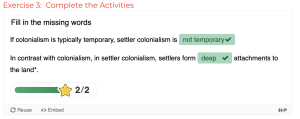
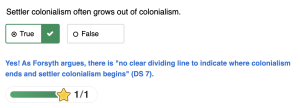
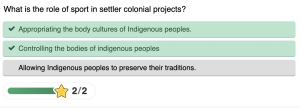
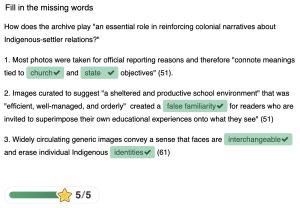
Exercise 4: Notebook Prompt
Although we have discussed in this module how the colonial project sought to suppress Indigenous cultures, it is important to note that it also appropriates and adapts Indigenous cultures and “body movement practices” (75) as part of a larger endeavour to “make settlers Indigenous” (75).
What does this look like? (write 2 or 3 sentences)
| This looks like the way colonial powers often took elements of Indigenous cultures, such as dance, rituals, and physical practices, and co-opted them into settler colonial society. Another example is the appropriation of Indigenous food practices. Settler colonial societies have taken traditional Indigenous foods and agricultural methods, such as corn, squash, and beans, and integrated them into mainstream agriculture or cuisine. This process reflects an effort to “make settlers Indigenous” by adopting select aspects of Indigenous culture but without recognizing the people or the lived experiences behind those practices.
|
D) The Colonial Archive
Exercise 5: Complete the Activities
Section Two: Reconciliation
A) Reconciliation?
Exercise 6: Activity and Notebook Prompt
Visit the story called “The Skate” for an in-depth exploration of sport in the residential school system. At the bottom of the page you will see four questions to which you may respond by tweet, facebook message, or email:
How much freedom did you have to play as a child?
What values do we learn from different sports and games?
When residential staff took photos, what impression did they try to create?
Answer one of these questions (drawing on what you have learned in section one of this module or prior reading) and record it in your Notebook.
| When residential staff took photos, what impression did they try to create?
When residential school staff took photos, they tried to depict the impression of the residential schools as efficient, well-managed, and orderly environments. The photos often depicted students and staff interacting in ways that seemed to suggest a productive, educational space, ignoring the harsh realities of abuse and the suppression of Indigenous culture. The group photos of the students convey mixed messages, with some students smiling while others either look away or have blank, expressionless stares on their faces. The photos conveyed a sanitized version of the schools, designed to present them in a positive light to the public while masking the trauma and suffering of the students.
|
B) Redefining Sport
B) Sport as Medicine
Exercise 7: Notebook Prompt
Make note of the many ways sport is considered medicine by the people interviewed in this video.
How is sport considered medicine?
- Reconnects you to previous generations and ancestors
- Specifically lacrosse, allows you to feel more connected to your heritage
- Sports feel like a release
- Playing with others fosters a sense of community and teamwork with others you share your culture with
- It was fun to play and was used as therapy
- The game is a gift from the creator, a medicine game
- Sports allowed ancestors to speak the language, and use it to their advantage within the game
C) Sport For development
Exercise 7: Notebook Prompt
What does Waneek Horn-Miller mean when she says that the government is “trying but still approaching Indigenous sport development in a very colonial way”?
| Waneek Horn-Miller is highlighting the fact that while there may be efforts to support Indigenous athletes or sports, these initiatives are still grounded in colonial frameworks that do not fully respect or integrate Indigenous cultural values, traditions, or systems of knowledge. The approach is still focused on fitting Indigenous sports into a colonial system instead of allowing Indigenous communities to shape sports in their own way. As well as not fully funding these athletes, compared to non-Indigenous athletes. Drawing from a previous video, one of the daughters from the Treadwell family, only receives $500 as a scholarship, when this is nothing compared to the costs she will face while attending post secondary. |
Exercise 8: Padlet Prompt
Add an image or brief comment reflecting some of “binding cultural symbols that constitute Canadian hockey discourse in Canada.” Record your responses in your Notebook as well.
|
The binding cultural symbols in Canadian hockey discourse might be a scene of players in iconic red and white jerseys, the Maple Leaf logo, or images of outdoor rinks with snow in the background. These symbols evoke a sense of national pride and connection to Canada’s historical and cultural relationship with the sport. Hockey is often depicted as a unifying force in Canadian identity, tied to notions of resilience, teamwork, and the Canadian winter experience. Hockey has been used to define and strengthen a sense of belonging for many Canadians, particularly in rural areas or among settler communities.
|
Section Three: Decolonization
Please see the major assignment for this half of the term in the final section of this chapter.
Here is my game map
https://ecampusontario.pressbooks.pub/anniecole/wp-admin/admin.php?page=h5p&task=show&id=47

